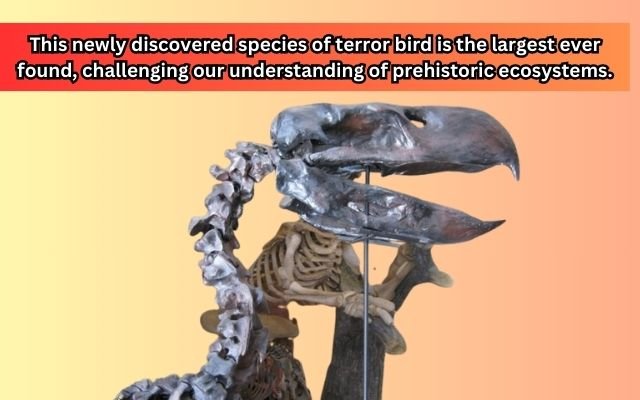Researchers Uncover Massive Ancient ‘Terror Bird’ Fossil in South America
A fossilized leg bone of a giant "terror bird" found in Colombia reveals it was a major predator in ancient South America millions of years ago.

According to scitechdaily.com a team of researchers, including a biologist from Johns Hopkins, has studied a fossil of a huge extinct bird that was likely a top predator. They believe it might be the largest “terror bird” ever found, giving us new clues about ancient wildlife in northern South America millions of years ago.
Discovery centers on leg bone of a massive “terror bird,” detailed in a new study published on November 4 in the journal Palaeontology. Research was led by Federico J. Degrange, expert in terror birds, along with Siobhán Cooke, Ph.D., an associate professor of anatomy and evolution at Johns Hopkins University School of Medicine.
The fossilized bone was found in Colombia’s Tatacoa Desert, an area known for its rich fossil beds and located at the northern tip of South America. This bone represents the northernmost evidence of this giant bird ever found in South America, helping scientists understand how these large, ancient predators lived and spread across the continent millions of years ago.
| Topic | Details |
|---|---|
| Discovery | A giant bird bone was found in Colombia, 12 million years old. |
| Research Team | Led by Federico Degrange and Siobhán Cooke from Johns Hopkins. |
| Importance | The first terror bird fossil found in northern South America. |
| Size and Features | The bird might be 5%-20% larger, 3-9 feet tall, and a fast predator. |
| Fossil’s History | Found 20 years ago, recognized in 2023, 3D scanned in 2024. |
| Bone Details | Similar to a human shin, with bite marks from a giant caiman. |
| Caiman Attack | The bird likely died from a caiman attack. |
| Ancient Ecosystem | The bird lived with giant sloths, armadillo-like animals, and primates. |
| Modern Relative | The seriema bird today is related to the terror bird. |
| Rarity | This is the only terror bird fossil found in this region. |
| Hidden Fossils | More terror bird fossils might be hiding in collections. |
| Reflection | Cooke imagines how amazing it would have been to see these extinct animals. |
Size and Features of the Terror Bird
The bone’s size suggests that this terror bird could be the largest of its kind ever discovered, estimated to be about 5%–20% bigger than other known members of its species, according to Cooke. Size of terror birds, which belong to the Phorusrhacids group, varied greatly; fossils from the past indicate that they were between three and nine feet tall.
Cooke explains that terror birds were ground-dwelling hunters with powerful legs built for running, helping them chase down prey. These birds were mainly carnivorous, using their speed and size to catch and eat other animals.
Leg bone of the terror bird was actually discovered almost 20 years ago by Cesar Augusto Perdomo, who is the curator of the Museo La Tormenta. But it wasn’t until 2023 that it was recognized as fear bird. Then, in January 2024, scientists made significant advancement by producing 3D virtual model of bone. They were able to investigate fossil more thoroughly without running danger of harm by using portable scanner from Johns Hopkins Medicine to record every feature. This advanced modeling has given scientists new insights into the bird’s size and structure, helping them better understand how it may have lived.
Fossil is the end of a left tibiotarsus which is a lower leg bone in birds that works similarly to a human shin bone. This bone dates back to the Miocene epoch, roughly 12 million years ago. It shows deep pits that are unique to the legs of Phorusrhacids, group that includes terror birds.
Interestingly, the bone has what appear to be teeth marks from an extinct species of caiman called Purussaurus, which was an ancient crocodile-like predator thought to reach up to 30 feet in length. These bite scars indicate that the Purussaurus attack most likely caused the giant terror bird’s death, Cooke said. A collision with one of these ancient crocodilians would have been highly dangerous for any creature at the time, given their size and power.
Importance of the Northernmost Discovery
Most of the fossils of terror birds have been found in southern parts of South America, particularly in countries like Argentina and Uruguay. However, discovery of a Phorusrhacid fossil as far north as Colombia shows that these birds were important part of the predator community in that region. Because it gives scientists a greater understanding of the ecosystem and species in northern South America some 12 million years ago, this discovery is essential.
Today, region is desert but scientists believe it was once land filled with winding rivers & lush habitats. Giant terror bird lived alongside many other large animals, such as primates, hoofed mammals, giant ground sloths and massive relatives of armadillos called glyptodonts, which were as big as cars. Interestingly, modern seriema bird, a long-legged bird native to South America that grows up to 3 feet tall, is thought to be a distant relative of these ancient terror birds.
Cooke explains that ecosystem of that time was very different from what we see today or even in other parts of world. This was a period before South and North America were connected, so types of animals and environment were unique to that time.
The fossil is thought to be the first of its kind found at this site, and it suggests that this species of terror bird was likely rare among the animals living there 12 million years ago, according to Cooke.
Cooke also believes that there might be other terror bird fossils already in existing collections that haven’t been identified yet. This is because the bones of these birds are sometimes harder to recognize than lower leg bone they discovered, which is a key part of identifying species.
For Cooke, this discovery brings to life ancient environment that no longer exists today. She imagines how fascinating it must have been to walk through a world filled with so many unique and now-extinct creatures.
- Solving the Biological Puzzle: Which Came First, Viruses or Bacteria?
- Midlife Crisis: More Than Just a Simple Story, Say Researchers
- Betelgeuse Has a ‘Betelbuddy’: New Findings on the Bright Star’s Companion
“It would have been incredible to see all of these animals, many of which are gone now,” she says, reflecting on what it would have been like to explore that ancient world.



